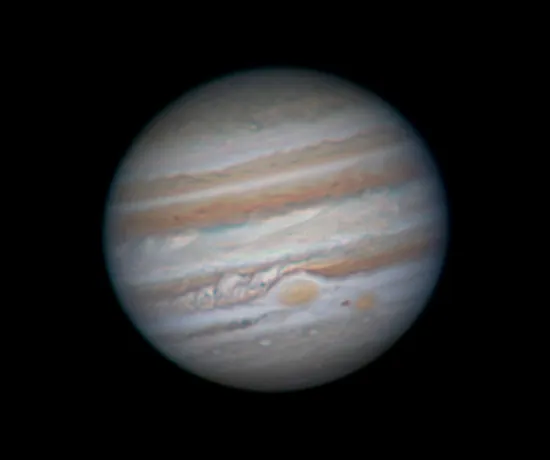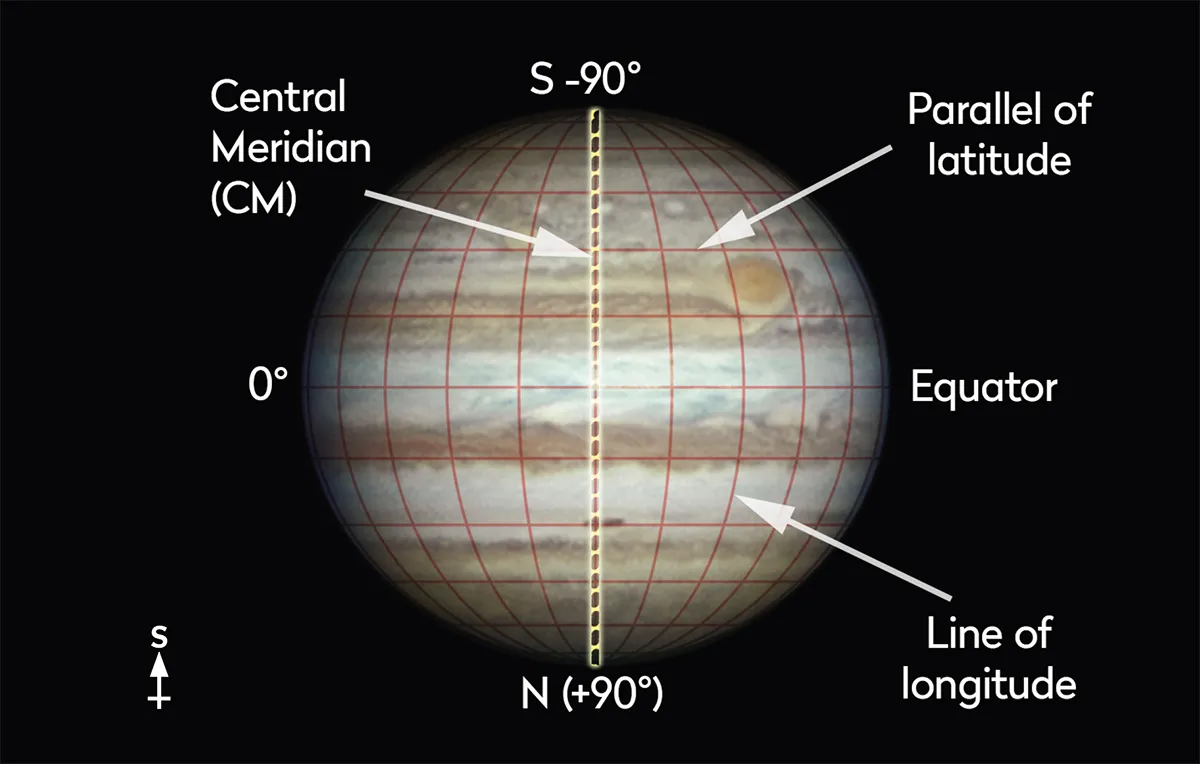When Earth is directly between the Sun and another planet, that planet is at opposition. This is a great time to view as the planet appears at its largest and brightest.
Gas giants Jupiter and Saturn are both coming to opposition in August 2021 and are impressive to view through a telescope for different reasons.
Jupiter’s dynamic atmosphere shows lots of detail and changes markedly over time.
Saturn’s atmosphere is subtler, but still has the potential to surprise.

And, of course, although Saturn’s globe doesn’t show the drama present on Jupiter, its rings are a constant draw.
Over previous years, both planets have appeared low from the UK, which has made observing them harder. The conditions are now slowly changing and it’s a great time to discover how to make scientifically useful observations of them.
Observing Jupiter and Saturn
Despite their great distances, Jupiter and Saturn are physically large enough to appear bright and with tangible size through a telescope.
Jupiter

Jupiter shows a wealth of detail, which is fascinating to record, either by sketching read our guide on how to draw Jupiter) or imaging.
As it rotates in less than 10 hours, you don’t have to wait long for its appearance to change. Indeed, wait too long and the planet’s fast rotation hides features and reveals new detail.
Saturn

Saturn rotates quickly too, but it’s a different world in terms of visual appearance.
Indeed, Saturn’s banded atmosphere is shrouded by a haze layer of ammonia clouds, making it hard to see detail. Here, visual and imaging skills need to be honed as much as possible.
One way to accomplish this visually is to make intensity estimates for different parts of the planet’s disc and rings (more on this below).
Also, if you can photograph the planet, you'll find that animation can help to emphasise subtle features on the edge of visibility.
Atmospheric variations
When we look at Jupiter and Saturn through a telescope, we’re looking at their atmospheres.
Observing Jupiter's atmosphere

Jupiter’s is most distinctive, appearing as a series of light and dark banded regions.
The famous storm known as the Great Red Spot (GRS) nestles into a scalloped-out region on the southern edge of the South Equatorial Belt (SEB).
The atmosphere is rich in shorter-lived phenomena too, such as light and dark spots, festoons and barges.
In addition, the visibility and appearance of belts and zones varies over time. In 2010, when the SEB disappeared completely, the GRS appeared odd as it floated, detached, around the planet.
Observing Saturn's atmosphere

Saturn has many belts and zones, but they are subtle and can be difficult to identify uniquely, whether visually or within images.
Saturn’s atmosphere does exhibit intricate detail but thanks to a high haze layer surrounding the planet, this detail is difficult to pick out.
Bright, light-coloured storms do occur in Saturn’s atmosphere from time to time. These can become quite extensive, so it’s important to make accurate recordings of their estimated size and changes in shape.
Large, long-lived Saturnian storms may spread until they virtually encircle the globe.
Gas giant coordinates

Jupiter and Saturn’s coordinate systems are equivalent to Earth’s latitude and longitude.
However, as there are no fixed surface features to use as anchor points, longitude-zero is more complex to define than the Greenwich Meridian, Earth’s line of zero longitude.
Latitude is easy: measured in degrees, it varies from 0˚ at the equator to 90˚ at either pole. By convention, northern latitudes are positive, southern negative.
Longitude determination is done by timing. Visualise an imaginary line running from the planet’s north pole to its south pole, and this imaginary line is known as the planet’s Central Meridian (CM).
As the rotation period of each planet’s atmosphere is known, it’s possible to define the Prime Meridian (zero longitude) as the longitude at the CM at an agreed, defined start time.
As the planet rotates, the CM longitude increases until it’s reset as the chronological Prime Meridian is reached again, one rotation later.
A complication occurs due to the equatorial regions rotating faster than the rest of the atmosphere.
This is addressed by dividing regions into two longitude zones: System I is used for the equatorial region between latitudes +10 and –10, while System II covers everything else.
However, a further longitude system also exists, known as System III, which reflects the time it takes for the planet’s magnetosphere to rotate.
Although System III reflects the official rotation period of each planet, amateur astronomers normally use System I and II.

Moving features on the gas giants' surfaces
Keeping track As Jupiter and Saturn rotate quickly, over several nights it’s relatively easy to see a specific atmospheric feature passing the CM.
For small features, accurately recording the time (in Universal Time) when this happens allows you to determine the longitude of that feature.
If you make longitude measurements of the same feature over a long period of time, ranging over months or even years, you will be ableto determine how much the feature is drifting within the planet’s atmosphere.
By plotting time versus longitude you can generate a drift chart to tell you a great deal about how the planet’s atmosphere works.
Features with tangible widths can be measured using the planet’s rotation.
Imagine the leading (preceding) edge of a feature reaching the CM at time Tp. The feature’s trailing (following) edge will pass the CM at time Tf.
The feature’s width can be determined by converting these to longitudes Lp and Lf using WinJupos.
The physical width in kilometres is calculated with the following formula:
- (Lf–Lp) x 1217.4 x cos(latitude)
All timings should be done in Universal Time and it’s important to use the correct longitude System, I or II.

This brings us to Jupiter’s Great Red Spot (System II), an extended feature.
CM timings of its preceding and following edges, along with timings that record its centre crossing the CM, give valuable information.
While edge timings give its width, the CM timing reveals its central longitude. Over the years the GRS’s physical width changes and its longitude drifts.
If you can master these useful scientific observing techniques, it will help to enrich your planetary observing for many years to come.
Using filters to observe Jupiter and Saturn

Filters can be used to enhance both visual and imaging sessions. The Wratten (W) scheme is commonly employed for visual planetary observation, with filters normally identified by ‘W’, followed by a number and sometimes a letter.
Visually, a light blue filter (W38A or W80A) enhances contrast within brighter zones and draws out detail in atmospheric clouds.
Light green (W57) and blue (W47) helps to darken brown-hued belts.
A W57 light green or a magenta (W30) filter also helps highlight Saturn's rings. Using a W30 filter, meanwhile, will brighten white ovals in Jupiter’s atmosphere.

When imaging, mono camera setups work best for filter work. Full colour images are made by imaging through red, green and blue imaging filters and combining the results.
Infrared (IR) pass filters produce high-contrast results, great for showing definition. Some colour cameras have good IR sensitivity and can be used in combination with such filters.
Speciality filters, such as those centred on the methane absorption band (CH4), produce valuable results for Jupiter.
Centred on a wavelength of 890nm and with bandpass windows typically less than 15nm across, light is at a premium with this filter making it more suitable for larger instruments. A CH4 filter brightens high-altitude atmospheric features.
Observing asteroid impacts on Jupiter

The gravitational pull of the gas giants inevitably leads to asteroid impacts. Those large enough to leave a mark are infrequent, but several have been reported and imaged on Jupiter in recent years (none has been reported on Saturn to date.)
As amateurs observe and image the planets regularly, they are the ones most likely to see and report such events.
If it’s a big impact that leaves a ‘scar’, professional observatories may divert busy schedules to take a look too. So it's important to report an impact site’s location accurately.
It takes experience to make a visual-only impact claim, but if the impact has been imaged, it’s easy to locate using WinJupos’s measurement scheme.
A non-scar impact typically appears as a brief flash. Impacts may occur when you’re looking away, so post-capture analysis with specialist software, such as DeTeCt, can help.
If you want to follow this route further, look at the Planetary Virtual Observatory and Laboratory (PVOL).
Making intensity estimates of Saturn

Using a telescope and your eyes, intensity estimates can be made of Saturn. You’ll need a planetary blank to show the correct outline of the planet for the observing date.
WinJupos can generate blanks by selecting Saturn from the Program > Celestial body… option, before choosing Tools > Ephemerides… and going to the Graphics tab.
Make sure the date is set correctly and turn off any textures, etc, to show a planetary outline which can be printed.
At the eyepiece, the intensity estimate is done by dividing the planet into areas of equal brightness.
A numeric scale of 0 to 10 is then used to annotate each area according to its brightness, 0 being bright, 10 dark.Intermediate, decimal values may be used if required.
In order to calibrate any estimates, two fixed areas are used. The outer part of ring B, the brightest of Saturn’s rings, is given an intensity of 1.
The dark shadow of the planet’s globe on the rings is given a value of 10.
In the case of the brightness value, brighter areas may be seen and these should be given decimal values less than one, up to a maximum of 0 for an exceptionally bright region.
Observer bias can be eliminated by first labelling regions brightest to darkest. Once complete, start on a new blank but label darkest to brightest.
Although tricky at first, it doesn’t take long before making accurate estimates becomes second nature.
The technique is also a great way to connect to Saturn visually, forcing you to look at every part of the planet.
This guide originally appeared in the August 2021 issue of BBC Sky at Night Magazine.

